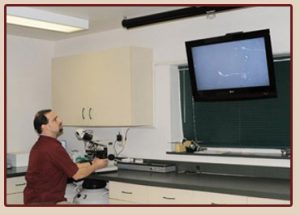
Reproductive Evaluations
Stallion reproductive evaluations are performed for a number of reasons. This type of exam may be a prelude to the breeding season or prior to purchasing a stallion for breeding purposes. Many times, a reproductive evaluation is done to assess damage after an injury or if a fertility problem is suspected. A stallion evaluation includes two semen collections an hour apart allowing each ejaculate to be evaluated for volume, motility, concentration and total sperm numbers. To assess bacterial growth, a set of cultures is taken from the prepuce, urethra and semen following each collection. In addition, semen and blood samples are tested for the presence of Equine Viral Arteritis (EVA) and morphology slides are made to assess structural integrity of the sperm cells. Lastly, the stallion’s testicles are palpated and evaluated for consistency, conformation, orientation and size. Once all results are gathered, a full report is provided to the stallion owner which provides descriptive details of the findings. The report makes recommendations on breeding procedures, treatment of any pathogens present, and the general suitability of the stallion as a breeding individual.
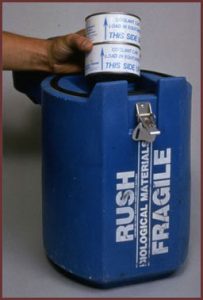
Colled Semen
ERC provides a cooled semen program that allows stallion owners to offer cooled, transported semen for their breeding operation without needing the knowledge, skills and equipment to do so. Staff at ERC will collect semen from your stallion and ship it to desired locations throughout the United States and Canada. For same-day service, semen can be collected in the morning, delivered by a courier on staff to Washington-Dulles Airport and shipped via airlines to the city/airport of choice. Next-day delivery is routinely done utilizing a Federal Express pickup service from ERC.
An initial test-cool panel is recommended for each stallion entering the program to determine which antibiotic in the extender and what cooling period bests suits the stallion. Samples from 1 to 2 ejaculates are cooled for 12, 24 or 48 hours in semen extender with or without antibiotics. Once there is a firm understanding of semen longevity, then recommendations are made as to the best method of shipping the semen.
With 24 hours advance notice, owners can trailer their stallion to ERC, allowing staff to unload and take him to the collection shed. Following semen collection, the stallion is put back on the trailer while the semen is processed for shipment. Many owners find this “drive-thru service” a wonderful asset to their breeding program. Although it is desirable to have stallions trained to the phantom, we do provide jump mares for untrained stallions.
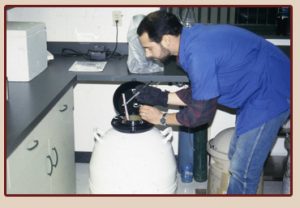
Semen Freezing & Storage
ERC offers a semen freezing service for those horse owners looking to expand their breeding program and/or preserve their stallion’s ability to produce offspring even after injury or death. The first step taken is to determine whether or not the stallion is a good candidate for semen freezing. This determination is based on the findings from a full reproductive evaluation and test freezing. Our freezing program is based on the vapor freezing method utilizing two different protocols and two different types of extenders. If an acceptable protocol is achieved, the stallion is collected every other day and the semen processed and frozen until the desired number of breeding doses is obtained. The frozen semen is cryogenically preserved in a tank filled with liquid nitrogen which maintains a temperature of
-196°C. ERC is an approved semen freezing facility for domestic use or export out of the United States.
Frozen semen can be stored at our facility for a monthly fee or shipped to any destination within or outside the United States. For shipping purposes, the frozen semen is packaged in a dry shipper charged with liquid nitrogen which maintains an adequate temperature for 7 to 14 days. Based on availability of shipping containers, breeding doses will be shipped directly to mare owner or practitioner up to 2 weeks prior to the breeding cycle.
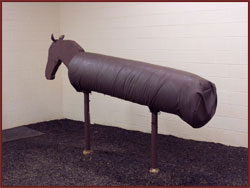
Phantom Training
A phantom is an inanimate object that a stallion mounts so semen may be collected. By utilizing this, you eliminate the need for a mare in heat. It also reduces the potential for injury and disease transmission inherent in live cover breedings. Most stallions can be trained to use the phantom within a two-week period. When adequately trained, stallions retain what they’ve learned so at any point in the future a phantom can be used without hesitation.
We have two phantoms at our facility. One is used for larger breeds of horses and the other is used for small, pony stallions. Each phantom has adjustable legs so angle and height can be tailored to fit various-sized stallions as well as those with injuries that prevent them from properly mounting. The phantom has been used successfully in retraining psychologically impotent stallions as well.
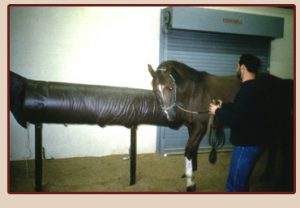
Problem Stallions
Often times, a stallion acquires either behavioral or physiological problems in the breeding situation. Stallions with sexual dysfunctions can exhibit any of the following issues: stale or sour attitude, over aggressiveness, self-mutilative behavior, slow breeder, inconsistent performance, inadequate erection, failure to ejaculate, mounting dysfunction and others. In most cases, these are due to inadequate methods of handling or managing the stallion. Abnormal behavior may also stem from a bad event that occurred with a mare during breeding. As a service, we do accept stallions that have acquired some undesirable breeding problems. Attempts will be made to retrain and/or find a management scheme that will allow the stallion to be functional at the farm again. Often times in conjunction with working with the stallion, we have to retrain the people in the breeding shed so there is a better understanding of what is acceptable and what is not. Certain management techniques may also be shared to help minimize problematic issues when breeding.
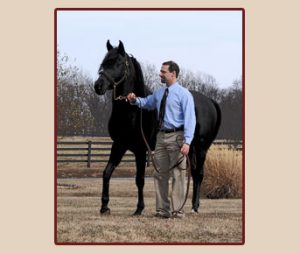
Standing Stallions
Stallions can be boarded at ERC for the breeding season as an alternative to trailering him in for collection when necessary. Although all stallions are welcomed to stay at ERC, priority for stall space will go to those stallions that have at least 15 mare bookings for the season. Although the stallion owner is responsible for the stud fees and breeding contracts, the only responsibility between the stallion owner and ERC is to make sure the staff at ERC are aware of which mares owners have permission to order semen. All verbal contact regarding collection, shipping arrangements, and billing are directly addressed between ERC and the mare owner.
CEM Quarantine Testing
Stallions that are imported into the U.S. as 2 year olds or older have to undergo testing for Contagious Equine Metritis (CEM). ERC has been approved to perform CEM quarantine testing on stallions and mares. Two test mares are naturally serviced by the stallion during this period but only after each mare has been blood tested for the presence of CEM and repeatedly cultured at the clitoral fossa and sinuses, uterine endometrium and cervix. Prior to breeding, cultures are taken from the stallion’s prepuce, urethral sinus and fossa. If all tests are negative for CEM then the stallion services each mare once. Following the breeding, reculturing occurs at the clitoral fossa and sinuses, endometrium and cervix of each test mare. A final blood test is done once all cultures are completed. After copulation, the stallion’s penis is thoroughly cleaned with chlorhexidine scrub and coated with nitrofurazone ointment for 5 consecutive days.
